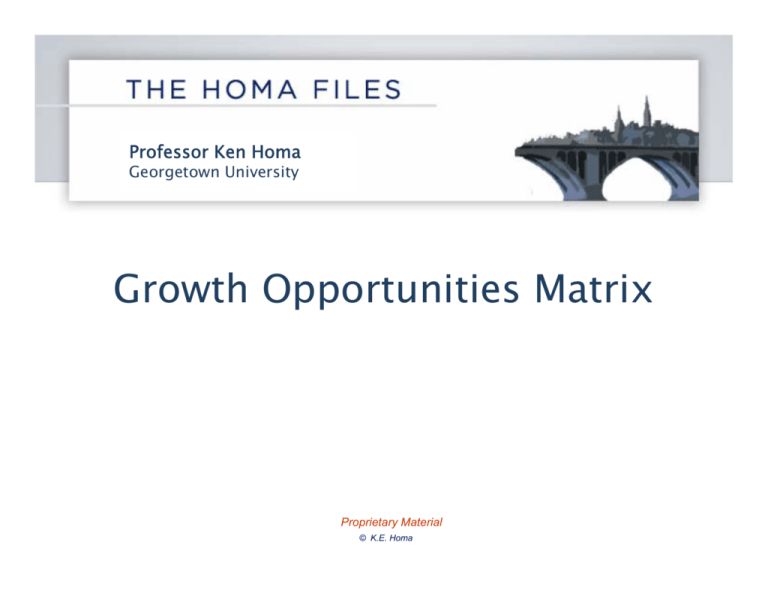Growth Opportunities Matrix
advertisement

Professor Ken Homa Georgetown University Growth Opportunities Matrix Proprietary Material © K.E. Homa Growth Opportunities Matrix • Generally credited to Igor Ansoff, circa 1965 • Other names: Ansoff Matrix, Corporate Strategy Matrix, Product/Market Expansion Grid • Objective: Distinguish among 4 generic growth strategies by categorizing them along 2 intersecting dimensions based on whether they are “established” or “new” products and markets. • Each of the quadrants has implicit tactical implications … and can be linked to supplementary frameworks. The Axes … Growth Opportunities Matrix Markets / Customers Old New • Original simply referred to “Markets”; “Customers” adds optional granularity • “Old” is shorthand for “Established” ... those customers and markets already being pursued … sometimes called “served markets” • “New” are markets and groups of consumers that are not being currently pursued … e.g. a company may be selling to commercial accounts but not to the consumer market …or may be doing business in the U.S. but not in Mexico. The Quadrants… Growth Opportunities Matrix Markets / Customers New Increase profitable sales of existing products to customers already being pursued (but not necessarily buying at the current moment). New Old Products / Services Old Customer Penetration Customer / Market Development n Cact Scust Sales TPcust i 1 Cpot n Served market(s) Cact active customers Cpot potential customers Scust sales per customer Market penetration TPcust total purchases (served) Share of wallet Customer Penetration: Basic Model Increase these rates Target Market x Penetration % Current Users x Usage Rate Consumption x Share Company Sales Customer Penetration: Increase number of users (adopters) Customer Penetration: Increase number of users (adopters) Related Frameworks • Bass Diffusion Model • Tech Adoption Framework • “Crossing the Chasm” Loyalty Ladder Customer Penetration: Increase usage (by current users) Customer Penetration: Increase usage (by current users) Increase Usage • New use occasions OJ – not just for breakfast • Increase volume per use Super-size it • Shorten replacement cycle New toothbrush every 30 days • Create new uses Baking powder in the fridge Customer Penetration: Increase share of customer purchases Goal is to build high customer loyalty, i.e. high, sustained share of customer purchases (at “full” price, high margins) Upward Migration Ladder Regularly buys all total purchases and doesn’t consider alternative sources Regularly buys all total purchases but shops around and entertains other offers Regularly buys a clear majority of total purchases Regularly buys a minority of total purchases for insurance against price gouging or supply discontinuities Buy occasionally when need arises. e.g. regular supplier is out-of-stock Customer Penetration: Increase share of customer purchases Committed customers often exhibit a “Loyalty Effect” … using more of a product, buying higher-end products, paying full price, promoting products to other potential customers, and buying more products from the company. Loyalty Effect Customer Penetration: Increase Customer Lifetime Value (CLTV) Ultimate measure of Customer Penetration is Customer Lifetime Value (CLTV) … the NPV of a customer\’s profit stream over time (versus on a single transaction), adjusted for acquisition (and retention) costs and the customer’s projected retention rate – which is usually considered inversely as a churn or defection rate. Customer Lifetime Value (CLTV) Growth Opportunities Matrix Markets / Customers New Old Products / Services Old New Increase profitable sales of existing products to groups of customers who are not currently being pursued Customer Penetration Market Development Market Development: Extend to new geographic markets or to new customer segments within existing geographies. Examples: A regional company “goes national” or a national company establishes a commercial presence in another country Example: Power Tools company selling to professional tradesmen begins offering products to consumer DIYers Market Development: Extend to new geographic markets or to new customer segments within existing geographies. Ties to Product Life Cycle (PLC) … Specifically, to “PLC Regeneration”, driving the PLC higher and longer Growth Opportunities Matrix Markets / Customers New Product Development Old Products / Services Old Customer Penetration New Sell a wider variety of products to current (existing) customers or upgrade products currently in use Market Development Product Development: New Product Strategies Product Development: Expanded product line Goal: Increase sales by leveraging established product positions into logical adjacencies. Product Line Expansion • Adjacent categories Coffeemakers ,Tea Kettles • Accessories Thermal carafes • Consumable Supplies Coffee filters • Services Extended warranty Product Development: Upgrade cycles Goal: Rejuvenate the PLC by introducing new and improved product versions. Growth Opportunities Matrix Old New New Product Development Diversification (Venturing) Old Products / Services Markets / Customers Customer Penetration Market Development Diversification (Venturing) • Principle: leverage “power alleys” and / or opportunistic innovations • “Grass is always greener …” • Tendency to overrate strengths and gloss over weaknesses • Individually more risky, collectively less Growth Opportunities Matrix Old New New Product Development Diversification (Venturing) Old Products / Services Markets / Customers Customer Penetration Market Development Professor Ken Homa Georgetown University Core Business Adjacencies Proprietary Material © K.E. Homa






